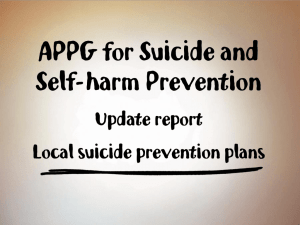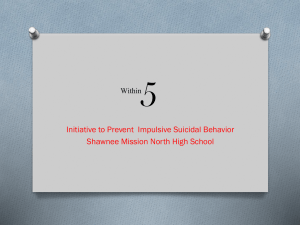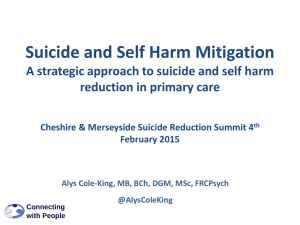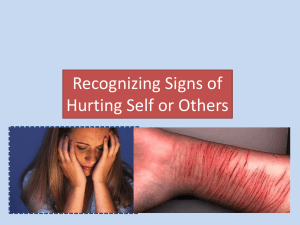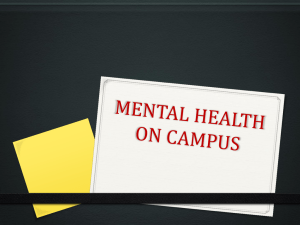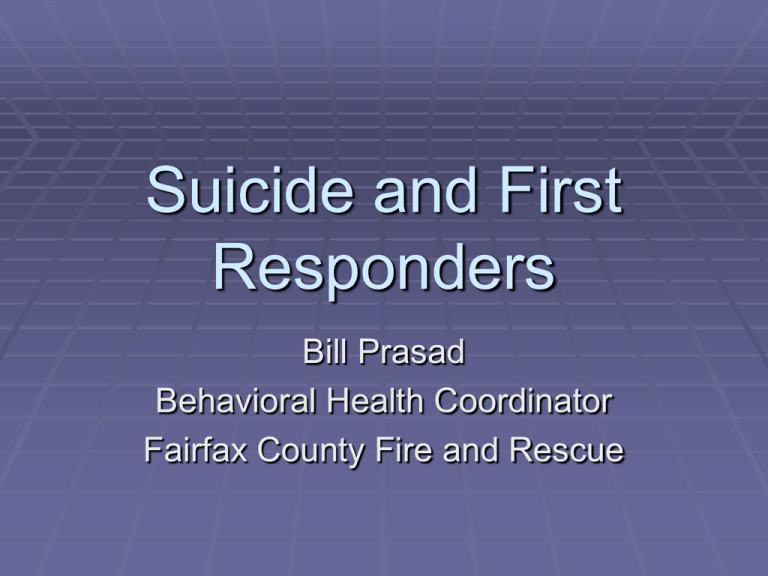
Suicide and First
Responders
Bill Prasad
Behavioral Health Coordinator
Fairfax County Fire and Rescue
Suicide in America
Deaths per year: 30,000
80 per day
One suicide every 15 minutes
Eleventh leading cause of death
Each suicide affects at least six people
800,000 attempts every year
5 million have attempted suicide
Firearms used in 52% of suicides
Suicide by Race/Gender
White males: 72% of suicides
White males and females: 90% of suicides
----------------------------------------- Firefighters: 96% male/85% white
Paramedics: 69% male/93% white
Police officers: 85% male/85% white
First responder population mirrors high
risk group
Suicide by Occupation
OSHA tracks only on-the-job deaths
Many states do not track deaths by occupation
NYPD: Suicide rate of 29 per 100,000 a year.
General population is 12 per 100,000
NYPD: Most were white males who shot
themselves while off duty
Nationally, twice as many police (300) complete
suicide as are killed in the line of duty
Suicide by Occupation
Chicago FD: 2008 to 2009
Firefighter Suicide
“A firefighter’s suicide strikes at the very
core value of the profession– teamwork.”
“When a fire department experiences this
tragedy, its impact can be emotionally and
mentally debilitating for the personnel left
behind to grieve.”
www.firechief.com
Suicides Per 100,000
20
18
16
14
12
10
8
6
4
2
0
Gen Pop
Military
White Males 21
to 55
Law
Enforcement
Completed Suicide
80
70
60
50
40
30
20
10
0
AOD/Mood Intoxicated
Disorder
at TOD
Previous
Mood
Disorder
Fire Arm
First Responder Risk Factors
Divorce
Trauma
Stress
Sudden fame
Divorce
National Rate: 50%
Police: 60 to 75%
Police: 80% of suicides linked to divorce or
relationship break-up
Fire: 50 to 65%
Fire: Many relationship break-ups linked to
24 hour shifts, OT, stress
Trauma/Sudden Fame
New York: Three firefighters who helped
rescue 9-11 victims killed themselves
within a year
Oklahoma City: A police sergeant who
rescued four victims at the bombed
Federal building completed suicide
Texas: A paramedic who helped rescue
baby Jessica McClure from a well later
took his life
Life Events as Triggers
Suicide/Death of loved one
Serious family illness
Loss of health
Loss of employment
Retirement
Financial problems
Legal problems
Life Events as Triggers
Victim of crime
Sexual assault/domestic violence
Witness to violence
Poor grades
Sexuality concerns
Substance abuse
Suicide Motivation
Loss or change in important relationship
To avoid or end perceived pain
Escape intolerable situation
Gain attention
Punish others/self
Become a martyr
Support System Warning Signs
Lack of support system
Rejected by peers
Separation from family or friends
Loner or newcomer
Feels like no one cares
Indirect Suicide Indicators
Buying a weapon
Giving away possessions
Making a will
Talking about a long trip
Taking unusual risks
Sudden religious interest/disinterest
Substance abuse relapse
Indirect Verbal Clues
I can’t go on any longer
I’m tired of life
Life has lost its meaning
I can’t take the pain
You’d be better of without me
You’re going to regret how you treated me
Direct Verbal Cues
I might as well be dead
I wish I were dead
If ------- doesn’t happen, I’m going to end it
I’m going to kill myself
Important Questions
Have you been thinking of hurting or killing
yourself?
When did you last think of suicide?
Have you ever attempted suicide?
Has anyone in your family attempted/completed
suicide?
Do you have a plan?
Do you have the means for carrying out plan?
Principles of Suicide Prevention
Programs
Encourage help-seeking behavior
High risk target population= more intense
effort
Age-specific
Developmentally appropriate
Culturally sensitive
Organizational Suicide Prevention
Programs
Supported/endorsed by senior staff and
union
Pamphlets, handouts, face-to-face
briefings
Everyone has a responsibility
Focus on identifying red flags
Have accessible help
Risk Factors
Sex (male)
Race (white)
Age (15 to 34) and (65+)
Depression
Previous exposure (self or family)
Loss of hope/rational thinking
Means and plan
No spouse or significant other
Illness
Sources
Suicide: Prevention, Intervention, &
Postvention, Clark, Thompson and
Welzant
World Health Organization, Preventing
Suicide
www.firechief.com
Suicide and First
Responders
Bill Prasad
Behavioral Health Coordinator
Fairfax County Fire and Rescue




